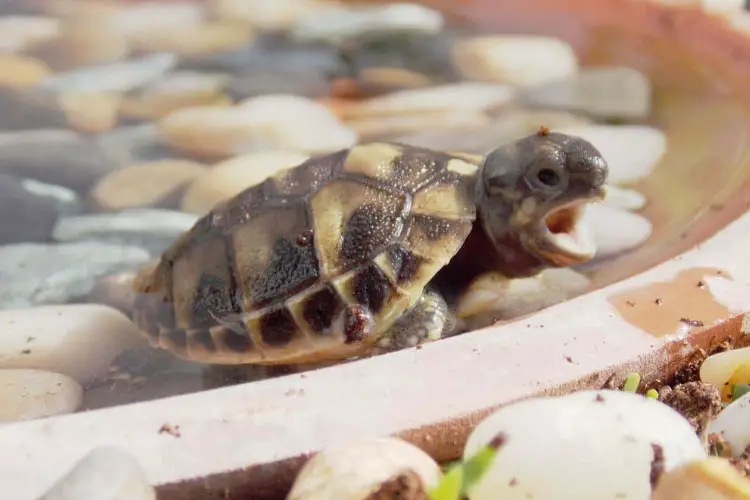Do Turtles Make Sounds? What Type Of Sounds Do Turtles Make?
Like mammals, birds, and amphibians, turtles and other reptiles also have a larynx or voice box. However, unlike most animals, the larynx in turtles lacks vocal cords. This may trigger a question that if turtles can make sounds or not.
Do turtles make sounds? Yes, Turtles can produce different sounds by removing air from their lungs even without vocal cords. They make common noises like grunting, hissing, squeaking, and chirping. However, turtles usually emit these sounds at a low pitch, making them hard for humans to hear.
But why do turtles make these sounds? Read our comprehensive guide to learn this and much more.
Do Turtles Make Sounds?
Contents
Yes, they do. Pet turtles boast a range of vocalizations, including high to medium chirps, grunts, squawks, clicks, clacks, growls, and cries. They usually emit these sounds when:

- Eating
- Mating
- Communicating with one of their own
- Stressed and feeling threatened
- Having an illness
However, most of the baby turtle vocalizations are hardly audible to the human ear. So, most turtle owners think these pets don’t make any noise. But how do turtles make a sound yet lack vocal cords, you ask?
What Type Of Sound Can Turtles Make?
Well, freshwater turtles can create distinct sounds by expelling the air inside their lungs. And interestingly, the type of sound a turtle produces varies based on its gender and species.

Having said that, below is a quick summary of the common noises turtles make and what each means.
| Type Of Sound | When Turtles Make The Sound |
| Hissing | Fear of the unknown Stressed Anxious When retracting into their shells Difficulty in breathing |
| Chirping | Bored or fatigued Hungry Stressed Change in environment Respiratory disease Unsuitable water temperatures |
| Grunting/honking | During mating Hungry Excitement when eating Emptying their lungs |
| Gurgling | Hungry Communicating with each other |
| Crying | In pain or suffering Have a respiratory infection |
Now, let’s look at the popular sounds most species of turtles make in detail while emptying their lungs.
1. Hissing
When a pet turtle is scared, anxious, or stressed, it usually retracts its body inside the shell. However, the turtle must push air out of the lungs to create extra room. As a result, it produces inaudible hissing sounds due to heavy breathing.
Here is a video of a box turtle producing a hissing sound before hiding inside its shell:
2. Grunting
Different species of turtles will often grunt to attract a potential mate. This audible sound is somehow shorter but more profound than hissing. Some river turtles may also make this audible noise to communicate they are hungry or show excitement when eating.
3. Chirping
Red-eared slider turtles are notorious for making this sound when bored or uncomfortable due to varying water temperatures. Sometimes, they produce this sound when stressed, exhausted, have a respiratory illness, or due to a change in environment.

4. Crying
Baby turtles usually make continuous crying sounds when hurt or suffering from blocked airways due to respiratory disease. The cries may sometimes sound like wails or little meows. Some aquatic species may also emit this sound when procreating.
5. Gurgling
Snapping turtles will make gurgling sounds to let their owner know when they are hungry. They can also use this sound to communicate with their fellow turtles.
Also read: Do Turtles Need A Companion?
Do Turtles Make Sounds At Night And Daytime?
While most pet turtle species are diurnal, meaning they are active in the day and sleep at night, their activity at night is not uncommon. This is especially typical with adult female turtles during the breeding season. They are more active at night.

And because of the total silence during the night, it is easier to hear turtle sounds. However, they usually make the same noises they produce during the day, especially when they are:
- Suffering from a respiratory condition
- Stressed
- Fatigued
- Startled by something
Can Turtles Make Squeaking Sounds?
Yes. Aquatic turtles can make tiny squeaks for many reasons. Sometimes, they will make this noise when begging for food from their owner instead of using the chirping or grunting sounds. Healthy female sea turtles also squeak when eating their food, basking, happy, and excited.

However, your red ear slider may also make squeaking sounds because they have a respiratory illness. You may hear the squeaks as your turtle tries to gasp for air with its mouth wide open. But to be sure this is the reason your pet could be squeaking; you must check for other signs like:
- Excess mucus in the mouth
- Discharge from the nose
- Wheezing sounds
- Extension of the neck
- Loss of appetite and lethargy
Do Turtles Hear Sounds?
Yes, which explains how they can communicate with each other via a variety of sounds and also detect predators. However, these lovely pets lack external eardrums. Instead, they have middle ear bones behind their skin flaps.

These bones help direct vibrations towards the internal ear canal and the brain for interpretation. As a result, your adult turtle can hear the sound and react to it. However, leatherback sea turtles cannot hear high-frequency sounds over 1,000 Hz, such as birds chirping. That said, they boast better hearing underwater than outside.
FAQs
Want to know more about the types of sounds social turtles make? Check out these commonly asked questions on the topic.
Marine turtles make sounds for different reasons. But in most cases, river turtles make noises when scared, stressed, excited, angry, or even aggressive. They also make sounds when warning one of their own about potential predators.
Yes, they do make mating noises. This is common, especially among male false map turtles. They usually make loud grunts or groan sounds to attract a mate while in the act. Therefore, you can easily hear the grunting noises.
Baby sea turtles make various low-frequency sounds that are difficult to pick on. You will hear these turtle species clucking, whining, chirping, crying, gurgling, and even grunting. The females also produce sighing and clicking sounds.
Related: Do Turtles Need a Water Heater?
Outro
Turtles use different sounds to communicate their feelings, such as when stressed, scared, hungry, ill, or happy. They usually make sounds like hissing, crying, grunting, and chirping, whether it’s during the day or at night. And even if they don’t have external ears, they can still listen to sounds and respond accordingly.


